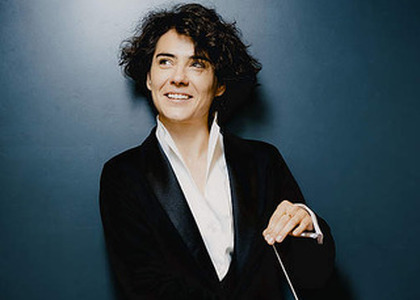> Interviews

Interview with conductor Marzena Diakun
This Friday evening, Polish conductor Marzena Diakun will take the podium of the Romanian Radio National Orchestra for the very first time. The program brings together Joseph Haydn's Symphony No. 44 in E minor and three French works - a repertoire the conductor has explored in depth throughout her career: Maurice Ravel's Alborada del gracioso and Concerto for the Left Hand in D major, alongside Paul Dukas' famous symphonic poem The Sorcerer's Apprentice. After one of the rehearsals, Marzena Diakun sat down for a conversation with our colleague, Ariadna Ene-Iliescu.
Let us start with the piece opening the program - Joseph Haydn's Symphony No. 44 - which is often considered a model of compositional craftsmanship, even among his own works. What is your perspective on this symphony?
I must say, I truly appreciate Haydn's symphonies. He always tries something new, something different, and he often uses humour. It's as if he's winking at the audience, hinting that there's something amusing or unexpected hidden within the music. He really plays with the form. Of course, the overall structure is classical, yet in this symphony, he flips the usual order of the second and third movements - placing the Adagio before the Minuet. The first and final movements follow the classical sonata form. In Friday's concert, we'll generally respect the written repeats. But I avoid rehearsing absolutely everything - because there are certain "surprises" I like to include in the interpretation along the way. If I intend to surprise the audience, it only works if that particular passage is played just once. Although this symphony is often referred to as the Trauer, or "Mourning Symphony", I believe it is equally full of a kind of subtle humour and deep sensitivity. The musical narrative is dense, energetic, yet at the same time filled with lyrical, cantabile lines. It's one of my favourites among Haydn's earlier symphonies.
If I may, I'd like to ask you a somewhat controversial question. You mentioned some interpretative "surprises" you have in store for the audience. I also observed your rehearsal with the Romanian Radio National Orchestra earlier. How much interpretative freedom do you feel you have with this score? Naturally, the symphony belongs to the Classical period, but also to the Sturm und Drang movement - and Haydn was a lifelong innovator…
For me, the most important thing is to understand the musical phrase. I follow it, I explore how it can be interpreted, what I can draw from it. For instance, the opening measures of the first movement have a certain energy - almost aggressive, I'd say - and then suddenly the mood, the dynamics, change completely; the register shifts. I observe what that phrase communicates and add my own emotion to the interpretation. Actually, I don't "add" anything - it's more about discovering what already exists within the phrase itself. That is why I feel I can bring something beyond what's written on the page. It was quite unusual for Haydn to notate certain types of pauses or tempo variations in the score - especially at that time. But I believe he may have imagined these moments as he composed, as he shaped the musical phrase in his mind. That's why I feel free to go beyond the literal notes. After all, notation is rarely all-encompassing. There's a world of expression beyond what's written.
The second part of Friday's concert features three works distinguished by their exceptional expressiveness: "Alborada del gracioso" and the Concerto for the Left Hand in D major by Maurice Ravel, and Paul Dukas' The Sorcerer's Apprentice…
I especially love French music and its vibrant orchestration. The initial concept behind this program was to create a Franco-Iberian soundscape, laced with folkloric influences. Originally, we were planning to perform El amor brujo by Manuel de Falla, with a traditional flamenco singer, in place of the Haydn symphony - but due to logistical reasons, the program had to be changed. Still, Alborada del gracioso retains that unmistakable Spanish character. As we know, Ravel was a master orchestrator, and he created this orchestral version himself from an original piano piece. The works in this program are all highly complex - rich in detail and instrumental nuance, whether we're talking about sound production, articulation, dynamics, or timbre. In a program like this, it is absolutely essential to go deep into the subtleties and highlight every small shift in articulation or attack - down to the finest details of each instrument.
Ravel's Concerto for the Left Hand in D major seems to emerge from the shadows - both metaphorically and literally, as notated in the score. How would you describe the musical narrative Ravel creates here?
I believe Ravel was a visionary for his time - a true pioneer in composition. Much of his music feels like it's written for the 21st century as well. He imagined astonishingly new sonorities, like those at the beginning of the Concerto for the Left Hand - so low and dark that we almost question what the instruments are playing. Some parts of the concerto may be difficult to fully grasp, shrouded in a particular kind of darkness - a form of despair that many people felt at that time. Much of Ravel's music doesn't seem to look toward the future with hope. And in this concerto, that darkness is especially palpable, not least because of the circumstances of its creation. The pianist for whom it was written had lost the use of his right hand - an injury from the war. The musical narrative Ravel crafts here is extraordinary, when you listen to it, it sounds as though it's being played not just with two hands, but with four! The piano part is so rich, so full, so complete. And the orchestral writing, as I mentioned earlier, is nothing short of revolutionary!
Translated by Oana-Elena Dragnea,
University of Bucharest, Faculty of Foreign Languages and Literatures, MTTLC, year I
Corrected by Silvia Petrescu














